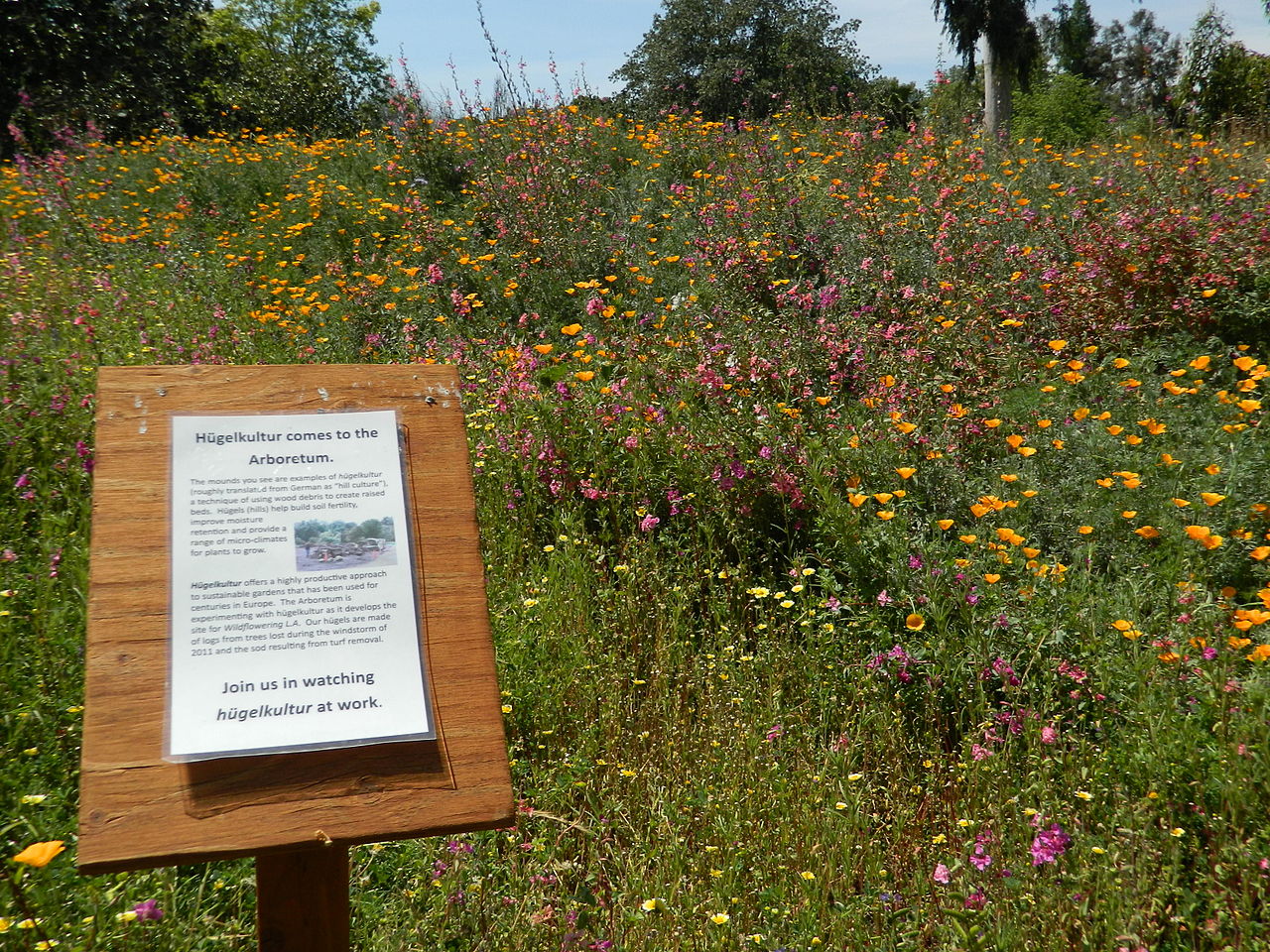Hügelkultur

Hugelkultur – photo source: wikipedia
Hügelkultur is a German word that we could translate as “cultivated hill“. It describes a cultivation technique for gardening or farming which uses wood waste as a resource. Quite simply, Hugelkultur consists of preparing a raised bed with a core of rotten wood.
Observation and imitation of nature
From observing a natural forest, we can see how wood waste and other organic material that falls on the ground can easily become impregnated with water, retaining rainfall and allowing it to be slowly released for the benefit of nearby plants. In addition, through the process of composting the organic matter, we make new nutrients available to the plants, which can then grow healthy. Through hugelkultur we try to mimic the water and nutrient cycle in a forest and gain numerous benefits.
How to do Hugelkultur
There are no precise rules regarding the size and shape of the flowerbed, but the larger the size, the better the results, especially with regard to the water cycle.
When sizing a flowerbed, the first factor to take into account is the availability of wood material. Depending on the amount of material we have or can recover, we can design our flowerbed taking into consideration that
- the flowerbed must be easily accessible at all points without being trampled on (trampling compacts the soil, making it more difficult for air and water to pass through);
- depending on the height, the flowerbed’s capacity to absorb and retain water varies. In order to obtain flowerbeds that do not need to be watered throughout the summer we need to be at least 1.5 m high. In this case, however, our flowerbed will smell during the first few months due to the large composting process taking place. With a smaller flowerbed, 60-80 cm high, we will not have this problem but the moisture will be retained for “only” three weeks.
If we have soil available or can easily take it from another part of our land, we can prepare our bed directly above ground level. If we do not have any soil available we can make a small excavation where we can place the wood waste and use the resulting soil to cover our flowerbed.

Photo: Wikipedia
The steps are as follows:
- Place the wood. The larger trunks at the bottom and the smaller branches and twigs at the top.
- Fill in the holes with nitrogen-rich material (green plant material, kitchen waste, manure).
- water thoroughly
- Cover with a 5-10 cm layer of soil.
The beds can be planted immediately, although they give the best results from the second year onwards. In the first year, the composting process of the wood (which is rich in carbon) absorbs a large part of the nitrogen present, stealing it from the crops. We can overcome this by either increasing the amount of nitrogen-rich material in the bed or by using wood that is in an advanced state of decomposition.
Advantages
The advantages of this cultivation technique can be summarised as follows
- Increased ability of the bed to retain moisture. The organic substance acts as a sponge, absorbing and retaining a lot of water in the soil.
- building up soil fertility. Through the process of composting wood waste, the soil in our flowerbed will become increasingly fertile and rich in life over the years.
- improving the drainage of the flowerbed. The pores and channels formed in the wood waste allow better drainage of excess water and improved air circulation in the soil.
- Use of wood waste that would otherwise be unused or burnt.
Choice of wood
The choice of wood is an aspect to consider when designing our raised bed. Some woods contain natural toxins and are therefore allelopathic (they release substances into the soil that inhibit the growth and development of other plants).
Plants such as oak, chestnut, fir or pine are naturally rich in tannins (substances which, among their functions, improve the resistance of the wood in a moist environment). It is best to wait until the wood is well seasoned before using them.
The woods to be avoided for the correct development of our flowerbed are those which have a high resistance to decay. For example:
- the carob tree
- walnut (it is also toxic to many plants)
- black cherry
On the contrary, they are excellent woods to use:
- alder
- poplar
- birch
- the apple tree
It is also preferable not to use living parts of trees or woods that might sprout and colonise your flowerbeds such as willow or acacia.
Hugelkultur – volunteer projects abroad
This section is new, help us improve it! If you are a host using Hugekultur techniques and you are looking for volunteers to help you, feel free to add your listing!





